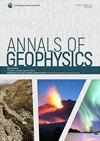VIGIL: A Python tool for automatized probabilistic VolcanIc Gas dIspersion modeLling
IF 1.2
4区 地球科学
Q3 GEOCHEMISTRY & GEOPHYSICS
引用次数: 2
Abstract
Probabilistic volcanic hazard assessment is a standard methodology based on running a deterministic hazard quantification tool multiple times to explore the full range of uncertainty in the input parameters and boundary conditions, in order to probabilistically quantify the variability of outputs accounting for such uncertainties. Nowadays, different volcanic hazards are quantified by means of this approach. Among these, volcanic gas emission is particularly relevant given the threat posed to human health if concentrations and exposure times exceed certain thresholds. There are different types of gas emissions but two main scenarios can be recognized: hot buoyant gas emissions from fumaroles and the ground and dense gas emissions feeding density currents that can occur, e.g., in limnic eruptions. Simulation tools are available to model the evolution of critical gas concentrations over an area of interest. Moreover, in order to perform probabilistic hazard assessments of volcanic gases, simulations should account for the natural variability associated to aspects such as seasonal and daily wind conditions, localized or diffuse source locations, and gas fluxes. Here we present VIGIL (automatized probabilistic VolcanIc Gas dIspersion modeLling), a new Python tool designed for managing the entire simulation workflow involved in single and probabilistic applications of gas dispersion modelling. VIGIL is able to manage the whole process from meteorological data processing, needed to run gas dispersion in both the dilute and dense gas flow scenarios, to the post processing of models’ outputs. Two application examples are presented to show some of the modelling capabilities offered by VIGIL.VIGIL:用于自动化概率火山气体分散建模的Python工具
概率火山灾害评估是一种标准方法,基于多次运行确定性风险量化工具来探索输入参数和边界条件的全部不确定性,以便概率量化考虑此类不确定性的输出的可变性。目前,利用这种方法对不同的火山危险性进行了量化。其中,火山气体排放尤其重要,因为如果浓度和接触时间超过一定阈值,就会对人类健康构成威胁。有不同类型的气体排放,但可以识别出两种主要情况:火山喷气孔和地面的热浮力气体排放,以及可能发生的密度流的密集气体排放,例如在湖泊喷发中。模拟工具可用于模拟感兴趣区域内临界气体浓度的演变。此外,为了对火山气体进行概率危害评估,模拟应考虑到与季节和每日风况、局部或扩散源位置以及气体通量等方面相关的自然变率。在这里,我们介绍了VIGIL(自动化概率火山气体分散建模),这是一个新的Python工具,用于管理气体分散建模的单个和概率应用中涉及的整个模拟工作流程。VIGIL能够管理从气象数据处理到模型输出的后处理的整个过程,该过程需要在稀气和浓气两种情况下运行气体扩散。给出了两个应用实例来展示VIGIL提供的一些建模功能。
本文章由计算机程序翻译,如有差异,请以英文原文为准。
求助全文
约1分钟内获得全文
求助全文
来源期刊

Annals of Geophysics
地学-地球化学与地球物理
CiteScore
2.40
自引率
0.00%
发文量
38
审稿时长
4-8 weeks
期刊介绍:
Annals of Geophysics is an international, peer-reviewed, open-access, online journal. Annals of Geophysics welcomes contributions on primary research on Seismology, Geodesy, Volcanology, Physics and Chemistry of the Earth, Oceanography and Climatology, Geomagnetism and Paleomagnetism, Geodynamics and Tectonophysics, Physics and Chemistry of the Atmosphere.
It provides:
-Open-access, freely accessible online (authors retain copyright)
-Fast publication times
-Peer review by expert, practicing researchers
-Free of charge publication
-Post-publication tools to indicate quality and impact
-Worldwide media coverage.
Annals of Geophysics is published by Istituto Nazionale di Geofisica e Vulcanologia (INGV), nonprofit public research institution.
 求助内容:
求助内容: 应助结果提醒方式:
应助结果提醒方式:


